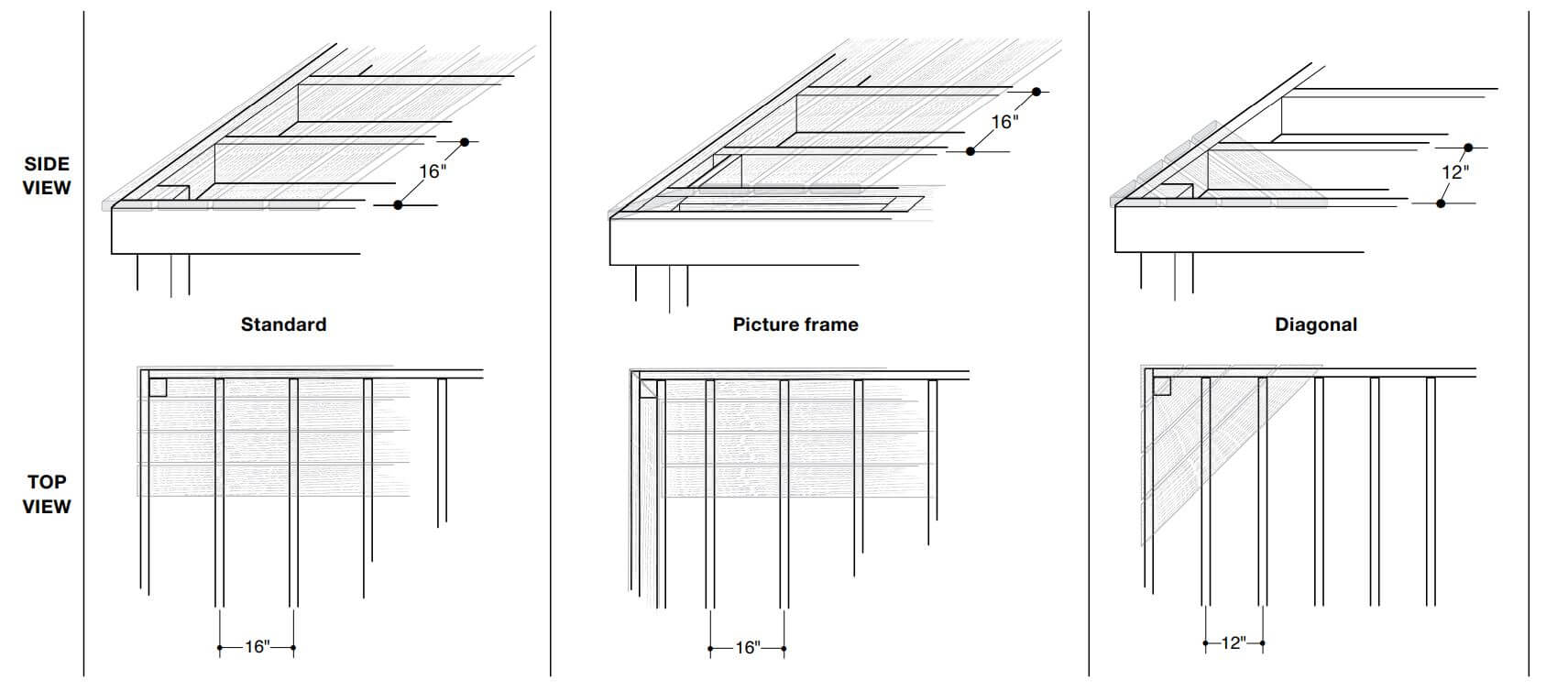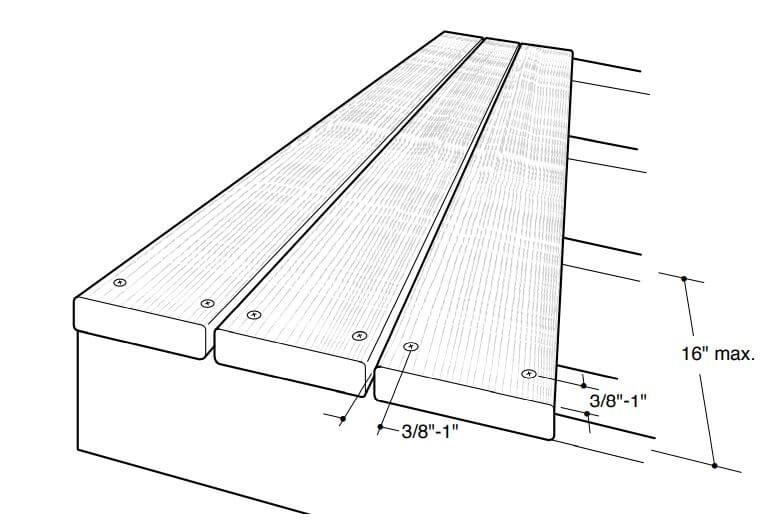Deckorators Mineral Composite Decking Installation Guide
Want to know how to install Deckorators mineral composite decking? Look no further, as below we provide a full set of installation instructions!
Items you will need before you start:
- Pencil/Pen
- Tape Measure
- Safety Glasses
- Utility Knife
- Jigsaw
- Carpenter Square (Speed Square)
- Screwdriver
- Soft Mallet
- Large or Medium Grit Sandpaper
- Chalk Line
- Spacing Tools
Voyage Deckorator has a unique experience and should ultimately be laid to the preference of the customer. That said, please pay attention to specific gapping, spacing and fastener requirements.
Joist Spacing For Your Decking
Joists should be spaced differently depending on the application. Use the table below to work out what the joisting space should be for your application.
| STANDARD | PICTURE FRAME | DIAGONAL (45 DEG) | |
| RESIDENTIAL | 400MM (16") | 400MM (16") | 300MM (12") |
| COMMERCIAL | 300MM (12") | 300MM (12") | 300MM (12") |

It’s important to bear in mind that solid bridging should be in place at locations where sustained heavy point loads from BBQ’s, fire pits, etc., are anticipated. The joist spacing in these areas should be reduced from 16” to 12” where the point load(s) will be applied (even in residential installations).
Board Gapping For Voyage Mineral Composite Decking
Gapping requirements between the boards are dependent on the installation temperature.
All wood and composite decking products require proper ventilation and drainage to ensure their longevity. When using a minimum 2x6 joist standing on edge and the suggested 1/4" side gap, there must be a minimum 2" clear space between the bottom edge of the joists and grade in order to allow for proper ventilation. Adequate drainage is also needed to prevent water from pooling under the deck.
Note: ONLY Deckorators Voyage, Vault, and Frontier decking material, manufactured with Eovations technology, may be installed with the ground or incidental submersion in water when a project design requires those conditions.
| ABOVE 0 DEGREES C | BELOW 0 DEGREES C | |
| SIDE-TO-SIDE | 3.18MM (1/8") | 4.79MM (3/16") |
| END-TO-END | 1.59MM (1/16") | 3.18MM (1/8") |
| END-TO-SIDE | 1.59MM (1/16") | 3.18MM (1/8") |
| ABUTTING SOLID OBJECTS | 3.18MM (1/8") | 6.35MM (1/4") |

Cutting Your Decking Planks
All decking/fascia boards should be cut with a clean/smooth saw blade – we’d recommend 10 or 12 inch circular blades.
Cut decking boards with the leading edge of the saw blade cutting into the exposed face. In areas where a circular saw cannot complete the cut, use a sharp utility knife or jigsaw.
A jigsaw should also be used to cut any area where planks protrude.
If needed, use a file or medium grit sandpaper to clean any cut edges and use a utility knife to cut any fibres or stands.
Note: In the rare event that a strand or fibre protrudes from the board, do not pull it.
Decking Board Installation
Quick Tips
Reverse-thread composite screws should be used during installation.
Screws should be 3/8" to 1" from the side of the board, 3/8" to 1" from the end of the board.
Use colour matched screws for best results.
Use caution not to overdrive screw.
We’d recommend two fasteners per joist minimum. The ends of each board must fall on a joist.
Double joist or use blocking where two board ends meet.
1" maximum overhang of boards at end of the joist.
Install the entire deck at the same temperature.
Fastening Your Boards
Install the deck boards starting from the outside edge of the platform and work towards the anchor wall so that the cut ends butt up to the wall. Start installing from one end of the board and work toward the other end of the board.
Alternatively, you can start your installation from the centre of the board and work out toward the ends of the board. Do not install by fastening each end first and working toward the middle.
Continue installing deck boards, taking on board the gapping requirements needed. Ensure consistent appearance by aligning each plank so that the emboss pattern always points in the same direction.
Note: Cutting all ends of boards prior to installation is recommended.
Hidden Fastener Installation
If you are using the Stowaway Hidden Fastener, then please follow the guide as per below:
For ease of installation, our Stowaway fastener fits into the groove on each side of the deck board to eliminate pre-drilling and provide a fastener-free deck surface. The deck boards require traditional fasteners on the outside and inside edges of the deck.
- Begin by fastening the outside edge of the first board to the rim joist every 16". For this, we recommend using 2-1/2" corrosion-resistant, composite wood deck screws. These screws help minimize the common “mushroom” effect that sometimes occurs when using standard fasteners. They can also reduce the amount of pre-drilling and countersinking. Note: If using ordinary coarse-thread deck screws, always pre-drill a pilot hole and countersink prior to driving screws. Screws must be driven flush with the surface. Do not over-tighten. Use one fastener per board every 16".
- Use two fasteners per deck board at each joist. For any decking where two boards meet end-to-end over a joist, additional blocking must be used for proper board end support (fig. 2). Always predrill a pilot hole when fastening within 1-1/2" of the board ends, whether using composite or wood screws. Do not over-tighten screws at board ends.
- On the other side of the board, place a Stowaway hidden fastener into the groove and centre on the joist (fig. 3). Install the preset screw at a 90° angle through the Stowaway fastener and drive flush. Do not over-tighten. The fastener wings must remain level with the joist for the next board to fit correctly (fig. 4).
- Install one Stowaway fastener at each joist location. Slide the next board into place so the wings on the previous fasteners fit into the groove on the side of the board. Make sure the side gap between the boards is 1/4".
- To keep the interior boards from moving over time, the boards must be pinned at the center of their length using a #8, 2" stainless steel screw. This holds the deck board in place at the center of each board and allows the decking to expand/contract at the ends. Pre-drill in the groove of the deck board with a 1/8" drill bit (fig. 5a). Drive the screw into the groove so it’s flush with the bottom of the groove (fig. 5b). This will allow you to properly fit a Stowaway hidden fastener into the groove.
- Install a Stowaway hidden fastener clip over the screw and centered over the joist. Fasten using a preset screw at a 90° angle through the Stowaway hidden fastener and drive flush with the clip (fig. 6). The fastener wings must remain level with the joist for the next board to fit correctly (fig. 4). Note: To predrill a groove on one side of deck board, we recommend using a 5/32" T-slot cutter.
- Install one Stowaway fastener at each joist location along the length of the board. For installations where deck boards are butted end-to-end at the joist, an 8” block must be added using a Stowaway hidden fastener clip at the end of each board (fig. 7 and fig. 8). Be sure to gap the boards as previously described.
- Repeat the process for each board until the outside edge of the final board is fastened with screws. Use fascia to conceal the board profile and inhibit board movement over time. Please refer to the fascia installation instructions for the approved fastening methods for fascia boards.
- If no fascia is being used, the entire perimeter of the deck should be fastened to the rim joist with screws. Use two screws per joist on the perimeter board. These screws will be inconspicuous once the railing is installed. Decking should be fastened with screws when being used as stair treads.



